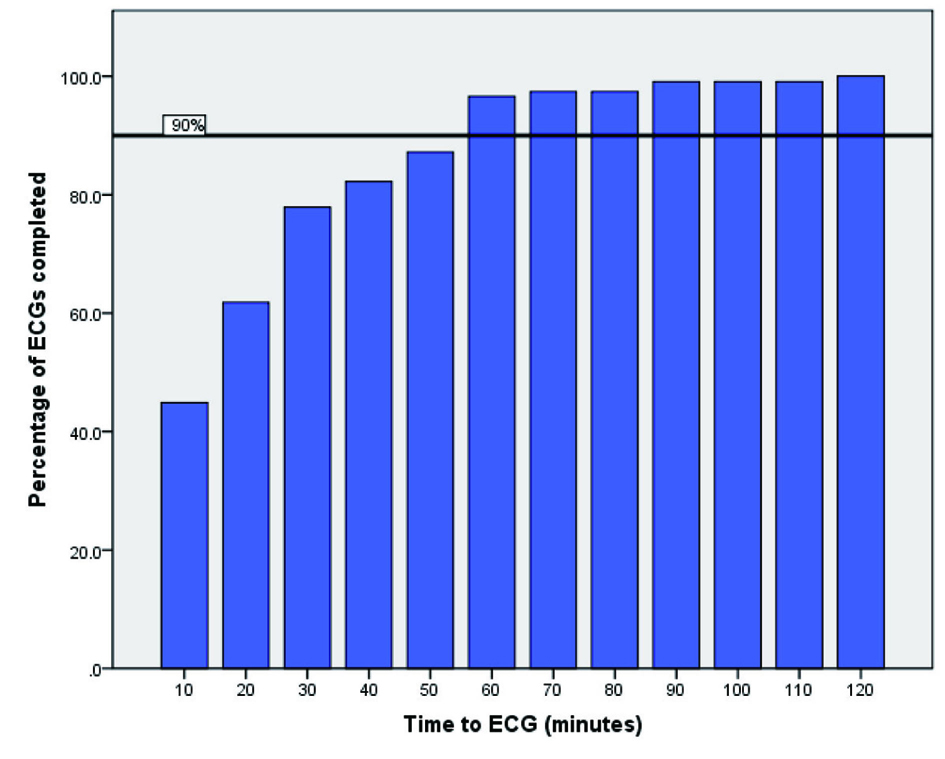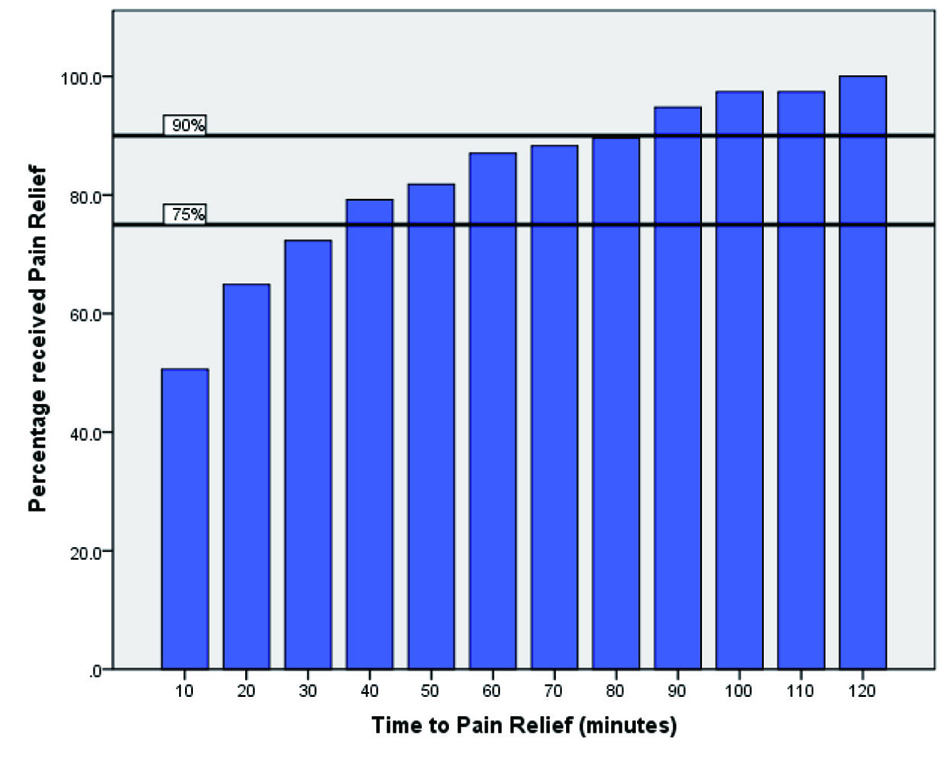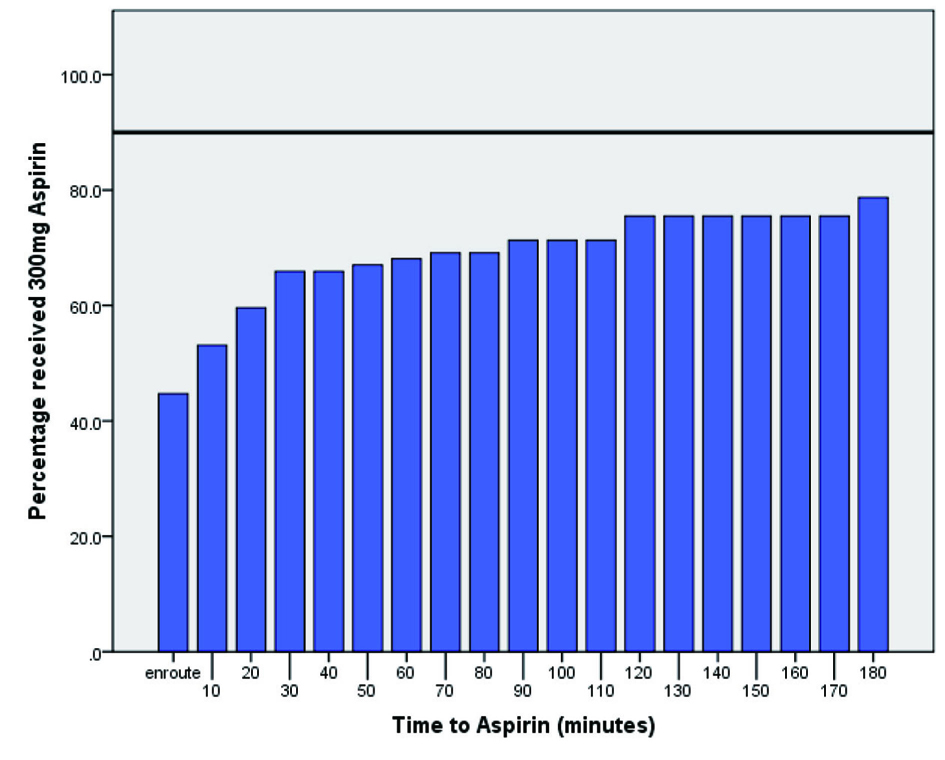
Figure 1. This bar graph highlights the time to initial ECG within the emergency department, versus the total number of completed ECGs. The College of Emergency medicine target of 90% ECG completion within 10 minutes is shown in black.
| Cardiology Research, ISSN 1923-2829 print, 1923-2837 online, Open Access |
| Article copyright, the authors; Journal compilation copyright, Cardiol Res and Elmer Press Inc |
| Journal website https://www.cardiologyres.org |
Original Article
Volume 3, Number 1, February 2012, pages 8-15
New Guidelines for the Management of Chest Pain: Lessons From a Recent Audit in Tauranga, New Zealand
Figures



Tables
| Summary of NICE Guidance regarding management of acute chest pain presentations |
|---|
| Take a resting 12-lead ECG as soon as possible. When a patient is referred, send the results prior to arrival provided this does not delay transfer. |
| Do not exclude an acute coronary syndrome (ACS) when patients have a normal resting 12-lead ECG. |
| Do not routinely administer oxygen. Monitor oxygen saturation using pulse oximetry as soon as possible, ideally pre-admission. |
| Only offer supplementary oxygen to: |
| -People with SpO2 <94% who are not at risk of hypercapnic respiratory failure, with a target SpO2 of 94-98% |
| -People with chronic obstructive pulmonary disease who are at risk of hypercapnic respiratory failure, with a target SpO2 of 88-92%, until blood gas available. |
| Tauranga Hospital % concordance and (number/all eligible) | |
|---|---|
| All aspects investigated correlate to NICE guideline 95, and established concordance targets are 100%. | |
| Initial Assessment | |
| Current Pain Status | 100% |
| Time of Onset | 100% |
| Resting ECG | 99.2% (117/118) |
| Pain relief (if required) | 91.3% (74/81) |
| Aspirin (if not allergic) | 78.7% (74/94) |
| Appropriate O2 usage | 54.4% (31/57) |
| Cardiac Marker tested | 97.5% (115/118) |
| Monitoring | |
| Pulse oximetry | 98.3% (116/118) |
| Pulse | 99.2% (117/118) |
| Blood Pressure | 100% |
| Pain | 94% (111/118) |
| Repeat ECG | 59.3% (70/118) |
| Telemetry | 57.6% (68/118) |
| Further Assessment | |
| Pain Characteristics | 100% |
| Associated symptoms | 93.2% (110/118) |
| Cardiovascular History | 98.3% (116/118) |
| Risk Factors | 77.1% (91/118) |
| Previous Episodes | 100% |
| Full Examination | 100% |
| P value | ||
|---|---|---|
| † investigated with Mann Whitney U-Test; ‡ investigated with Fisher’s exact test for contingency tables; *denotes statistical significance at the 10% confidence level;**denotes statistical significance at the 5% confidence level. | ||
| Time of Admission | Time to ECG † | 0.784 |
| Time to Pain Relief † | 0.342 | |
| Time to Venepuncture † | 0.783 | |
| Pain Monitoring ‡ | 0.352 | |
| Telemetry ‡ | 0.177 | |
| Repeat ECG ‡ | 0.039** | |
| Patient Age | Aspirin use | 0.067* |